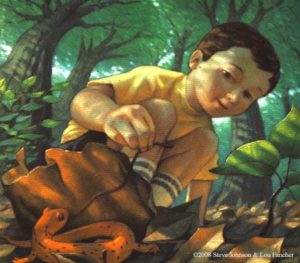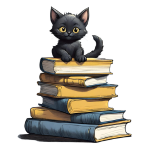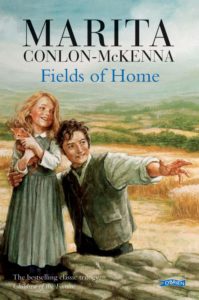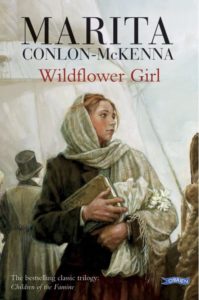I found The Salamander Room by Anne Mazer in a second-hand bookstore here in Islamabad and it is SUCH a treasure. This is a story about little Brian who finds a salamander and wants to keep it in his room. What follows is a series of gentle questioning from his mum – it’s really sweet that she doesn’t say “Euww! No way!”
She asks how he will cater to the creature’s needs – “Where will he sleep?” etc. Brian answers all of her questions and concerns with imaginative solutions:
- make a bed for the salamander with leaves and moss
- bring in crickets and bull frogs to lull it to sleep
- collect wet leaves, stumps and boulders for the salamander’s play
- bring in other salamanders for company
- make a pool and bring in insects for the salamander’s food and drink
- control the insect population by bringing in birds and bullfrogs
- provide trees and ponds for the birds and bullfrogs
- lift off his room’s ceiling so the sun can shine through, trees can grow and so the birds can fly freely
I love how Steven Johnson’s illustrations chart Brian’s grand dreams. As the story progresses with each addition, this creative child’s bedroom is transformed into a lush jungle paradise!
 The Salamander Room is a wonderful example of how a living book can be a springboard to nature studies and science. Your little one will be introduced to topics like cause and effect, habitats, amphibians, rainforests, ecology and how we can do our bit to care for the environment.
The Salamander Room is a wonderful example of how a living book can be a springboard to nature studies and science. Your little one will be introduced to topics like cause and effect, habitats, amphibians, rainforests, ecology and how we can do our bit to care for the environment.
Some activities you can do with your kids:
- Check out Five in a Row for a great learning adventure.
- Reading Rainbow has very nice free educational guides for this book.
- Homeschool Share has a salamander lapbook.
- Mama’s Learning Corner has a literature-based unit study on this book.
- As We Walk Along the Road has a very detailed unit study guide about salamanders … this is part of her awesome free ebook The Ultimate Book of Unit Studies for Literature Lovers.
This review was first published on Imaan.Net in August 2005 and has been updated for this site.
Salamander image by @issa_user via Twenty20




 Peggy, meanwhile in Boston, is acutely lonely – she is trapped in drudgery and her two friends are moving on. Kitty, her fellow maid, has moved on to serve in another house and Sarah, her beloved friend is moving West to better her health and prospects. James, Sarah’s brother, proposes to Peggy and asks her to come along. Despite her dire circumstances, Peggy is unwilling to settle and wants a true soul mate.
Peggy, meanwhile in Boston, is acutely lonely – she is trapped in drudgery and her two friends are moving on. Kitty, her fellow maid, has moved on to serve in another house and Sarah, her beloved friend is moving West to better her health and prospects. James, Sarah’s brother, proposes to Peggy and asks her to come along. Despite her dire circumstances, Peggy is unwilling to settle and wants a true soul mate.
 Peggy braves horrifying conditions on the month-long journey across the Atlantic. The poor passengers endure sea-sickness, cabin fever and wretchedly awful meals. Peggy survives this ordeal with the help of a friend, Sarah.
Peggy braves horrifying conditions on the month-long journey across the Atlantic. The poor passengers endure sea-sickness, cabin fever and wretchedly awful meals. Peggy survives this ordeal with the help of a friend, Sarah.